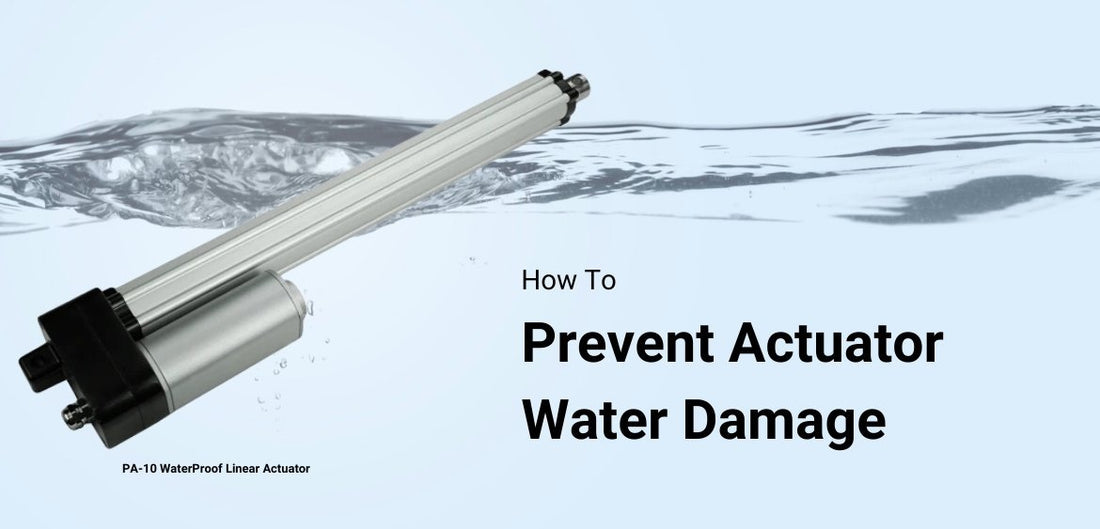Electric Linear Actuators are used to automate different types of applications in different environments. It would thus be important to ensure that your actuator is well protected from water damage.
Effects of water damage
Using an actuator in humid or moist environments, submerged in water or used near water can lead to overtime water damage if the IP rating is too low or there aren’t sufficient protective measures. Water damage can cause an actuator’s internal components to short circuits such as its limit switches, diodes, and motor. A unit that has short-circuited, may not operate correctly or may become permanently non-operational. An actuator’s housing, gears (metal) and motor can also rust over time without sufficient water protection.
The images below indicate some of the effects water damage would do to an actuator.

A few techniques that can help reduce actuator water damage include:
• Selecting the right IP rating
• Adding covers around an actuator
• Mounting in positions away from the direction of water
IP rating
IP (ingress protection) rating is a standard used to indicate the level of protection a unit has against dust, debris, and water. In cases where actuators are intended for outdoor use or will be exposed to a fair amount of moisture, an IP65 rating or higher would be recommended. Other applications that require an actuator to be submerged underwater is recommended to use something with IP67 or higher. Water damage can still happen while an actuator is moving because the IP ratings are from test data when the actuators were not in motion. Referring to the IP Rating Chart would be recommended to confirm what IP ratings are most suitable for an application and selecting a higher rating allows for more safety factors.

Actuators such as the PA-06 and PA-10 are examples of actuators with IP ratings sufficient for submersions underwater (Above or equal to IP67M). The PA-10 also has Salt Spray rated versions with specialized porcelain plated housing, useful for applications that require the extra corrosion resistance. The PA-14 and PA-14P actuators come with an IP54 rating but can be custom ordered for an upgrade to IP65. It may be more beneficial for some applications to have a modified design to fit an actuator with the right IP rating instead of using an actuator that fits but will get water damaged after a short time of usage.
Covers around an actuator
Covers provide an additional layer of protection and may come in many different shapes and forms. Some examples of covers would include rubber boots, body casings, and overhang roofs.

The actuator rubber boots we offer, such as the AC-05 (Actuator Rubber Boot for PA-14) AC-20 (Rubber Boot for PA-14P) are examples of covers that can go around an actuator. It would also be possible to design/fabricate a body case to protect an actuator like how a phone case adds some protection for a phone.
Additionally, overhang roofs can be installed above an actuator to reduce the volume of water that falls vertically down onto the unit, similar to how roofs on houses would work. These covers can be something designed as part of the project that required the actuator. Adding a cover around an actuator does not increase the overall IP rating. However, the cover can provide additional protection which would have been previously not present at all.
Mounting positions
The position an actuator is mounted-in can affect how much water falls onto the shaft and eventually risk flowing into the shaft’s housing. Even if an actuator has a high IP rating, it would still be recommended to point the actuator’s shaft downwards if possible when used outside. This is to ensure that the unit will operate with a longer life span in case the seals get damaged over a long period of time, the IP rating is not valid when seals are compromised. Also, this reduces the build-up of excessive debris accumulated on the stroke rod. For vertically mounted actuators, the motor can be facing up while the shaft points downwards so water falls down and away from the shaft housing.


Horizontal motion achieved by a diagonally mounted actuator
In cases where horizontal motion is required, an actuator is typically expected to be mounted horizontally as well. With some designing and modification, it would be possible to achieve horizontal motion using a diagonally mounted actuator as seen in the image above using mechanical leveraging. When diagonally mounted, gravity can help a little at pulling water drops away from the shaft housing that is angled downwards. Although not as effective as facing vertically downwards, it is still an improvement over having it mounted horizontally. Gravity does not play a role in decreasing the water intake into the shaft housing when the actuator is mounted horizontally.
Water damage may cause an actuator to fail or not function at maximum potential. Selecting actuators with the right IP rating would be recommended to help prevent water damage and provide a longer life span. Even for the actuators with high IP ratings, using extra covers and suitable mounting positions to protect the units from water damage improves the overall longevity. If you have any further questions, you may call us at 1-800-676-6123 or email us at sales@progressiveautomations.com




